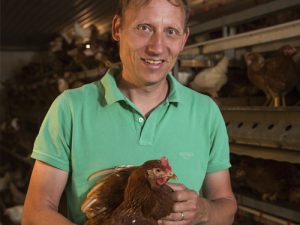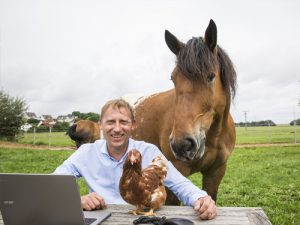The Kratzer farm had initially seven hectares of arable land and seven cows, with the current farmer succeeding from his father and grandfather. Over the past few years, there have been significant changes. All the fruit grown on the farm along with the eggs from 3,000 chickens are refined and sold in the farm shop. On the arable land, the farmer, with the help of his family and foreign workers, grows almost exclusively food for the chickens. The grass from the meadows is dried for hay production and fed to the 16 pension horses.
Area: approx. 15ha
The father of the present manager took over the running of the farm from his grandfather in 1968. At that time the farm consisted of seven hectares of land and seven cows. The father grew sugar beet, malting barley, wheat and starch potatoes. Later he bought his first chickens. In the past, pig fattening was the principle type of agricultural production. After the farm was handed over, the focus turned more to refining, processing and marketing. The prede- cessor also managed a piggery together with six other companies. In 1970, a stable (farm building) was built, with sufficient space for 1600 pigs. This was very innovative at the time and enabled the business to become financially sustainable. The stable was sold in 1988 to one of the partners and it is still in operation today. In 1996, the current farm manager took over the farm and now manages it full-time with two family part-time workers, a full-time em- ployed worker and nine other part-time employees.
The farm engages in a variety of different activities. There are 15 hectares of arable land on which wheat, corn and soybeans are grown. The sowing, spraying and harvesting of the crops are outsourced activities. Furthermore, the successor is a member of the board of a machinery ring , which he co-founded in 1993 along r with six other farmers. On the farm, 16 horses are kept in a modern stable following the HIT-concept. The design of this stable enables the horses to live in accordance with their natural patterns of behaviour. In addition, they are in a group, can move freely, and are optimally supplied with food and are very resistant to diseases and “boxing behaviour”. The farm also en- gages in poultry production (chickens) and direct marketing. In total, 3000 chickens are kept on the farm. The eggs are sold mainly through the wholesale trade. Every year, the company produces 30-40 tons of noodles and a certain amount of eggnog. These are distributed primarily through the farm shop.
The company has gained valuable experience through cooperating with colleagues and agricultural companie, par- ticularly in production, processing and marketing.
1. Cooperation in production:
The farmer works in co-operation with two other farmers with respect to laying hens. The farmers manage their own stables with Mr. Kratzer and another farmer rearing 3,000 laying hens each whilst the other farmer has = =2,000 laying hens.
Mr. Kratzer buys the majority of the eggs from the two farmers. The surplus eggs are sold by the farmers separately.
In addition, there is a machine ring in operation since 1993 under the stewardship of Mr. Kratzer.
2. Cooperation in processing
Mr. Kratzer offers a pasta making service to other farmers. By undertaking this activity, he uses his bespoke tech- nical equipment to allow customers to generate an added value from their products, specifically the production of pasta.
3. Cooperation in marketing
In 2000, Mr. Kratzer developed an idea to sell eggs produced in the region under a common brand. Despite the project progressing to an advanced stage, it was never implemented.
In the current marketing campaign, he cooperates with other farm shops and producers with respect to the product range. In addition to his own farm produce, he also sells sausages, meat and potatoes produced by other farmers.
In many instances, this is based on reciprocity. Other farm shops sell his noodles and eggs in their offer. There is no contractual regulation for this activity and each producer is free to make their own decisions.
Mr. Kratzer was innovative in all areas of cooperation activity and was looking for partners who had particular strengths in marketing.
He is aware that cooperation and mutual responsibility go hand in hand. In this respect, he is glad that the two farmers he is cooperating with have built their own stables. However, he understands that the two farmers also rely on his marketing success and the added value which stems from the locally produced produce. Overall, a significant level of trust has been honed and developed amongst the farmers.
Mr. Kratzer sees the leading entrepreneur as a key player in a cooperation activity. However, these people can also reach their limits.
He sees a great challenge in harmonizing supply and demand together in tandems with processes and procedures associated with production, processing and marketing, thereby utilising resources optimally.
Optimization is important to him. He sees the machine community / ring with 23 members as being unused potential if there is not additionally to pure machinery excellent sfaff to use the sensitive technology for the farmers.
With regard to the necessary competences for successful cooperation, Mr. Kratzer outlines the following:
- Strategic planner
- Forward thinking
- Effective communicator
Mr. Kratzer views his cooperation activities as being very successful, in retrospective, he would make little differ- ence with respect to how he has managed the farm holding. The openness for cooperation is important to him.
However, times have changed too with ever increasing competitiveness within the agricultural sector. Grow or leave the market: this is noticeable trend at the latest since the biogas boom in Germany with which the competition for agricultural land increased sharply.
Today, he would react and act earlier when a partner does not just what he promises or simply does not stick to agreements or practices.
Advice/Recommendation
"Start in small steps, eg with a machine community for managing the arable land. That is something, which one can leave immediately, without which of the involved ones has to take huge financial losses. Of course Win-Win is attractive but keep in mind also mutual dependences are increasing. You have to develop personally and as an entrepreneure to this situation. Making directly a Big Investment together and at the very beginning is dangerous!"
Queries/Questions
- Even if the farmer is very successful in all his cooperation activities he recom- mends to start step by step. Do you see it like he does?
- The farmer is engaged in cooperations in all fields of products cycle: production, processing, selling. Being on his own this could be difficult to handle. Being a team and in cooperation makes the whole thing work. What do you think about that?



 Čeština
Čeština  English
English  Français
Français  Deutsch
Deutsch  Italiano
Italiano  Slovenščina
Slovenščina  Español
Español 


